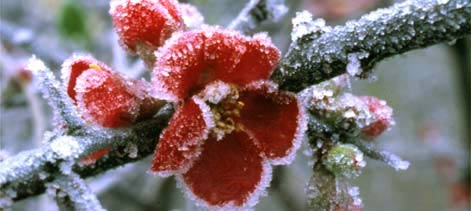Several plants, like basil and tomatoes, require considerable vigilance until the June summer heat arrives.
Big Idea
- No need to protect or cover your cool-season plants
- Tropical plants are a different story
- This week there may be a Frost
- The two crucial times of the year you need to be on frost alert are in spring and late fall
- Read more…
Be ready to move frost-sensitive plants indoors when an unexpected frost occurs
Many plants love everything about spring in the mountains. There is no need to protect or cover your cool-season plants. Plants like a pansy, calendula, kale, daffodil, and Iris celebrate during cold nights. Tropical plants are a different story.
Plants like basil and tomatoes require considerable vigilance until the June summer heat arrives. Without protection from this week's possible Frost, these tropical plants are at risk. This does not mean you should abstain from growing warm-climate or tropical plants early. You need to keep an eye on the weather and protect them from Frost if necessary.
Why Frost is so Dangerous to Summer Plants
Frost causes the water in plant cells to freeze, severely damaging the cell walls. This gives a plant the typical wilted look after a frost.
Even hardy fruit trees such as Cherry and Peach can suffer frost damage. It usually occurs when unseasonably warm weather in late winter or early spring coaxes the trees into an early bud break and bloom. Frost can injure the buds and blossoms and affect that year's harvest. The tree will be just fine, but the spring fruit is concerned.
When to Take Protective Steps
The two crucial times of the year when you need to be on frost alert are in the spring and late fall. Two holidays mark this last Frost of spring (Mothers Day) and the first potential Frost of Fall (Halloween). Have all the materials and equipment to protect plants ready so you can act promptly when there is a frost advisory.
Container Plants
Frost sensitive plants you overwintered indoors, wait until after Mother's Day before moving them outdoors. Be ready to move them back indoors for the few nights when Frost is expected. This is when your investment in a rolling plant caddy comes in handy.
If you don't want to move plants indoors when the risk of Frost is expected, place a large cardboard box over your plants. Make sure not to bruise the foliage. If you have several plants, you can place them under a patio table and cover the table with blankets and sheets to create a warm tent effect. A chair turned upside down over a plant and covered with a sheet can do the job for smaller plants. Cover plants with a textile, fabric, or burlap, not plastic, so the plants can breathe. The plastic used to insulate plants often does more damage than good. Use breathable materials.
Small Fruit and Fruit Trees
Small fruits such as blueberries and small fruit trees can be covered with a sheet or burlap. Strawberries are sensitive to spring frosts because they often bloom before the last May frost date. If there is a frost warning, cover them with a thick layer of straw just for the evening and remove it the following day. You might have to do this a few times until the danger of frost has passed. Leaving straw on strawberries during the day deprives your plants of light.

Larger fruit trees can be covered with frost cloth, with a shop light hung in the tree for added protection. Christmas tree lights throw off enough warmth when strung through the branches of a tree to protect fruits forming at the tree's heart.
Vegetables
Broccoli, Cabbage, Swiss chard, Lettuce, Radishes, Beets, and Leeks are cold-hardy and survive Frost. Fall and winter Kale, Collard greens, Parsnips, Jerusalem Artichokes, Rutabagas, and Brussels sprouts taste better when harvested after several touches of Frost.
A single frost event can damage tropical vegetables like peppers, tomatoes, and eggplant growing in the gardens. Protect your plants with bubble wrap held in place by stakes or a tomato cage.
Seedlings
Cold sensitive tomatoes, peppers, melons, cucumbers, and the like need to adapt to their outdoor surrounding over a week. Expose seedlings to sunlight a little longer every day. Bring your seedlings back in the house, heated garage, or basement for the night until planted in the garden after the last average frost date in May.
Water
A hydrated plant survives cold temperatures far better than a dry plant. Water helps your plants stay warmer at night. Give your seedlings, Vegetables, Fruits, and Containers a deep soak the night before an expected frost event.
When Do Plants Die of Frost?
Cold-sensitive plants need to be covered in either a frost or a freeze warning. Any temperature under 36 degrees warrants a frost advisory. A light freeze warning is advised when garden temperatures are expected to drop between 28 and 32 degrees for five consecutive hours.
Frost-damaged plants look wilted first, then turn brown, leading to black death. The foliage is often brittle because roots can no longer take up water. The plant will not recover from this type of killing Frost and is best replaced.
April through May, you can plant warm climate or tropical plants. You simply need to keep a watchful eye on the weather and protect these plants from potential Frost when necessary.
Ken Lain
Watters Garden Center
Ken Lain can be found throughout the week at Watters Garden Center, 1815 W. Iron Springs Rd in Prescott, or contacted through his web site at www.wattersgardencenter.com or Facebook page www.facebook.com/WattersGardenCenter
Watters: Website | Facebook | YouTube | Instagram | Pinterest




















